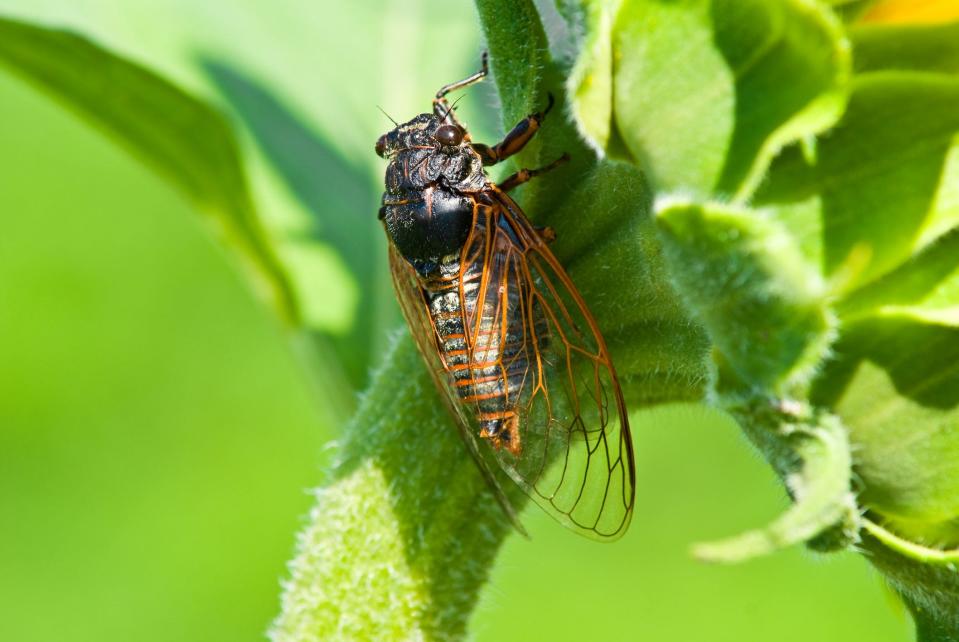Trillions of cicadas to emerge in coming months, some in Texas. Here's what to know
It's a bird, it's a plane, it's ... a double brood of cicadas?
That's right. This spring is bringing in a rare natural phenomenon. Beginning in April and through to early summer, Texas and several other states will see two broods of cicadas surface from the ground for the first time in over 200 years.
Trillions of cicadas are expected to emerge from the two broods, according to the University of Connecticut. Don't worry — the noisy insects will not emerge all at once or from the same place.
'Trillions' of cicadas? See how and where dual cicada broods will emerge in 2024
The involved broods are Brood XIII, located in Midwestern states, and Brood XIX, located across the Midwest and South. Brood XIII emerges every 17 years, while Brood XIX emerges every 13, according to U.S. News & World Report.
The dual emergence only occurs every 221 years, and 2024 falls into that pattern.
Dr. Gene Kritsky, professor emeritus of Biology at Mount St. Joseph University, spoke to KVUE about the event's rarity.
"What makes this rather unusual is that both broods are emerging during the same year," Kritsky said. "Now the last time these two particular broods emerged together was in 1803. To give people some historical perspective, that's when Thomas Jefferson was president of the United States."
The next dual emergence won't happen again until 2245.
What is a cicada?
No, this isn't something from the Book of Revelations — locusts and cicadas are separate species.

There are at least 15 cycles, or "broods," of periodical cicadas, some of which emerge every 17 years, while others emerge every 13 years. Different broods of cicadas emerge in different parts of the eastern half of the USA in different years. Other species show up every summer.
The bugs have been seen only as far west as Texas and Oklahoma and have not been spotted beyond those states.
What does this mean for Texas?
Fortunately — or unfortunately, if you really like cicadas — Texas will be largely unaffected by the dual emergence. Only parts of the state will experience the event, Molly Keck, a San Antonio-based entomologist with Texas A&M AgriLife, told the Dallas Morning News.
“Bugs don’t know borders,” said Keck. “It’s possible people in parts of very East Texas will see and hear these cicadas.”
Map: Cicadas expected to emerge in various parts of the US
There could be as many as 1.5 million cicadas per acre, which brings the brood population into the trillions.
Unable to view our graphics? Click here to see them.
How long will the cicadas be around?
It depends on the weather and location, but both massive broods will emerge starting in mid-May and ending in late June.
Billions of cicadas will emerge in the Mississippi River basin this spring.
If the weather is consistently warm and dry, the cicadas will finish mating sooner rather than later, which would mean a shorter season. Typically, their lifespan is four to six weeks, and they will start to die off in late June.
How big are the cicadas?
They’re 1 to 2 inches long with a wingspan of 3 to 4 inches.
Do cicadas bite or sting?
No. Cicadas aren't equipped to sting like bees or wasps. They do have prickly feet that could poke your skin if held.
Cicadas aren't dangerous. They're not harmful to “humans, pets, household gardens, or crops,” according to the Environmental Protection Agency.
Cicadas can be dangerous to young trees, though. The EPA says cicadas lay their eggs in small tree branches, which can harm the tree. To protect maturing saplings, cover them in mesh or netting to keep the insects out. On the upside, larger trees are not at risk.
Contributing: Mary Walrath-Holdridge and Liam Gravvat
This article originally appeared on Austin American-Statesman: Cicada broods to emerge in rare phenomenon, releasing trillions in US

